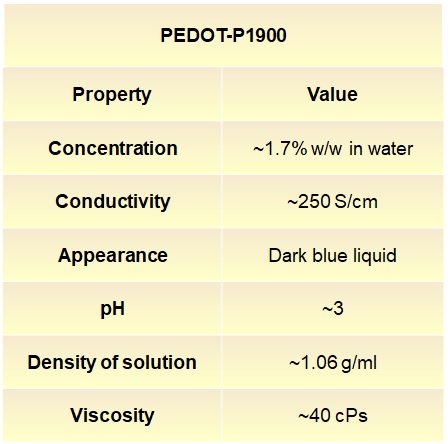PEDOT-P1900 TM: Fully Formulated Multipurpose Ink
This product is designed to spread and adhere to plastic and glass substrates such as:
- Polycarbonate (PC)
- Polyethylene terephthalate (PET)
- Polyimide Kapton
- Borosilicate glass
PEDOT-P1900TM can be easily applied by traditional methods, such as paintbrush, slot die, drawdown bar etc. Heating at ~200F for 10 minutes allows curing the ink thus rendering it insoluble and more mechanically stable. The amount of additives was carefully balanced to maintain good conductivity while achieving good mechanical properties.

Applications of PEDOT-P1900 TM may include transparent electrode in OLEDs, flexible displays, flexible solar cells, strain sensors and Electroluminescent (EL) devices.
Available quantities: gr, Kg, Liters.
Minimum order quantity 30g. Please contact us for more information and prices.
Samples of all products may be purchased for initial evaluation.
Disclaimer: The information provided herein, including all further technical advice are for general guideline purposes only. This information is based on our present knowledge and experience and is believed to be correct and reliable. However, no warranty is expressed or implied regarding accuracy of the information. In view of the many factors that may affect processing and application, THE SELLER MAKES NO WARRANTIES, EXPRESS OR IMPLIED, INCLUDING, BUT NOT LIMITED TO, THE IMPLIED WARRANTIES OF MERCHANTABILITY AND FITNESS FOR A PARTICULAR PURPOSE. The User assumes all risk and responsibility for, any use or handling of any material beyond our direct control. It is the sole responsibility of the Buyer to test the performance and suitability of the Material on his/her applications. We reserve the right to make any changes according to technological progress or further developments. Nothing contained herein is to be considered as permission, recommendation, nor as an inducement to practice any patented invention without permission of a patent owner.